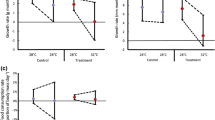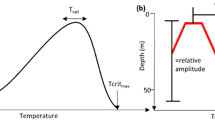Abstract
Salmon sharks, Lamna ditropis, belong to a small group of sharks that possess vascular counter-current heat exchangers (retia mirabilia) allowing retention of metabolically generated heat, resulting in elevated body temperatures. The capacity of free-swimming lamnid sharks to regulate rates of heat gain and loss has not been demonstrated. Using acoustic telemetry, we recorded swimming depth and stomach temperature from four free-swimming salmon sharks in Prince William Sound, Alaska. Temperature data were obtained over time periods ranging from 3.8 to 20.7 h. Temperature profiles of the water column were obtained concurrently for use as estimates of ambient temperature. Mean stomach temperature among four individuals tracked ranged from 25.0 to 25.7°C. These sharks defended specific elevated temperatures regardless of changes in ambient temperature, which ranged from about 5–16°C. The maximum observed elevation of stomach temperature over ambient was 21.2°C. Because stomach temperatures were so strictly maintained relative to changes in ambient temperature, a thermal rate coefficient, k, (°C min−1 °C thermal gradient−1) for cooling of 0.053 min−1 was obtained via a `control' experiment with a dead salmon shark. We show that free-swimming adult salmon sharks maintain a specific stomach temperature independent of changes in ambient temperature through a combination of physical and physiological means, and essentially function as homeotherms. This unique ability is probably the underlying factor in the evolutionary niche expansion of salmon sharks into boreal waters and in their ability to actively pursue and capture highly active prey such as salmon.
Similar content being viewed by others
References
Anderson, S. D. & K. J. Goldman. 2001. Temperature mea-surements from salmon sharks, Lamna ditropis, in Alaskan waters. Copeia 2001: 794-796.
Bernal, D., K. A. Dickson, R. E. Shadwick & J. B. Graham. 2001a. Review: Analysis of the evolutionary convergence for high performance swimming in lamnid sharks and tunas. Comparat. Biochem. Physiol. A 129: 695-726.
Bernal, D., C. Sepulveda & J. B. Graham. 2001b. Water tunnel studies of heat balance in swimming mako sharks. J. Exp. Biol. 204: 4043-4054.
Burne, R. H. 1923. Some peculiarities of the blood vascular system of the porbeagle shark, Lamna cornubica. Philos. Trans. Roy. Soc., London 212: 209-257.
Blagoderov, A. I. 1994. Seasonal distribution and some notes on the biology of salmon shark (Lamna ditropis )in the north-western Pacific Ocean. J. Ichthyol. 34: 115-121. (Originally published in, and translated from, Voprosy Ikhtiologii. )
Block, B. A., H. Dewar, S. B. Blackwell, T. D. Williams, E. D. Prince, C. J. Farwell, A. Boustany, S. L. H. Teo, A. Seitz, A. Walli & D. Fudge 2001. Migratory movements, depth pref-erences, and thermal biology of Atlantic bluefin tuna. Science 293: 1310-1314.
Brill, R. W., H. Dewar & J. B. Graham. 1994. Basic concepts relevant to heat transfer in fishes, and their use in measuring the physiological thermoregulatory abilities of tunas. Env. Bio. Fish. 40: 109-124.
Carey, F. G., J. G. Casey, H. L. Pratt, D. Urquhart & J. E. McCosker. 1985. Temperature, heat production, and heat exchange in lamnid sharks. Southern California Academy of Sciences, Memoirs 9: 92-108.
Carey, F. G. & K. D. Lawson. 1973. Temperature regulation in free-swimming bluefin tuna. Comparat. Biochem. Physiol. 44: 375-392.
Carey, F. G., J. M. Teal & J. W. Kanwisher. 1981. The visceral temperatures of mackerel sharks (Lamnidae). Physiol. Zool. 54: 334-344.
Compagno, L. J. V. 2001. Sharks of the World. An annotated and illustrated catalogue of shark species known to date. Bullhead, mackerel and carpet sharks (Heterodontiformes, Lamnifor-mes and Orectolobiformes). FAO Species Catalogue for Fishery Purposes, No. 1, Vol. 2 Rome, FAO. 269 pp.
Dewar, H., J. B. Graham & R. W. Brill. 1994. Studies of tropical tuna swimming performance in a large water tunnel, II. Thermoregulation. J. Exp. Bio. 192: 33-44.
Eschricht, D. F. & J. Müller. 1835a. Ñber die arteriösen and venösen Wundernetze an der Leber und einen merkwu ¨rdigen Bau dieses Organes beim Thun sche, Thynnus vulgaris. Physikal Abhandlungen der Konig. Wissenschaften Berlin. pp. 1-32.
Eschricht, D. F. & J. Müller. 1835b. Nachtrag zu der Abhand-lung der Herren Eschricht und Müller über die Wundernetze an der Leber des Thun sches: U ¨ber die Wundernetze am Darmkanal des Squalus vulpes L., Alopecias vulpes Nob. Physikal. Abhandlungen der K. Wissenschaften Berlin, pp. 325-328.
Fudge, D. S. & E. D. Stevens. 1996. The visceral retia mirabilia of tuna and sharks: an annotated translation and discussion of the Eschricht & Mu ¨ller 1835 paper and related papers. Guelph Ichthyology Reviews 4: 1-92.
Goldman, K. J. 1997. Regulation of body temperature in the white shark, Carcharodon carcharias. J. Comparat. Physiol. B 167: 423-429.
Goldman, K. J. 2002. Aspects of age, growth, demographics and thermal biology of two Lamniform shark species. Ph. D. dissertation. College of William and Mary, School of Marine Science, Virginia Institute of Marine Science. 220 pp.
Goldman, K. J., S. D. Anderson, J. E. McCosker & A. P. Klim-ley. 1996. Temperature, swimming depth, and movements of a white shark (Carcharodon carcharias)at the South Faral-lon Islands, California. pp. 111-120. In: A. P. Klimley & D. G. Ainley (eds. )Biology of the white shark Carcharodon car-charias, Academic Press, San Diego, CA.
Goldman, K. J. & J. A. Musick. 2005. Biology of the Salmon Shark, Lamna ditropis. In: E. K. Pikitch & M. Camhi (eds. ) Sharks of the Open Ocean. Blackwell Scientific.
Hickman, C. P., L. S. Roberts & F. M. Hickman. 1984. Inte-grated Principles of Zoology, 7th edition, Times Mirror/ Mosbey College Pub, St. Louis, MO.
Hochachka, P. W., W. C. Hulbert & M. Guppy. 1978. The tuna power plant and furnace. pp. 153-181. In: G. D. Sharp & A. E. Dizon (eds. ) The Physiological Ecology of Tunas, Academic Press, New York.
Holland, K. N., R. W. Brill, R. K. C. Chang, J. R. Sibert & D. A. Fournier. 1992. Physiological and behavioral thermoregula-tion in bigeye tuna (Thunnus obesus). Nature 358: 410-411.
Holland, K. N. & J. R. Sibert. 1994. Physiological thermoregu-lation in bigeye tuna, Thunnus obesus. Env. Biol. Fish. 40: 319-327.
Kitagawa, T., H. Hakata, S. Kimura & S. Tsuji. 2001. Ther-moconservation mechanisms inferred from peritoneal cavity temperature in free-swimming Pacific bluefin tuna, Thunnus thynnus orientalis. Mar. Ecol. Progr. Ser. 220: 253-263.
Lowe, C. G. & K. J. Goldman. 2001. Thermal and bioenergetics of elasmobranchs: bridging the gap. Env. Biol. Fish. 60: 251-266.
McCosker, J. E. 1987. The white shark, Carcharodon carcharias, has a warm stomach. Copeia 1987: 195-197.
Nakano, H. & K. Nagasawa. 1994. Distribution of the salmon shark (Lamna ditropis )in the North Pacific Ocean and Bering Sea. Salmon Report Series, No. 37: 226-237. National Re-search Institute of Far Seas Fisheries, Shimizu Japan.
Neill, W. H., R. K. C. Chang & A. E. Dizon. 1976. Magnitude and ecological implications of thermal inertia in skipjack tuna, Katsuwonus pelamis (Linnaeus). Env. Bio. Fish 1: 61-80.
Neill, W. H. & E. D. Stevens. 1974. Thermal inertia versus thermoregulation in ''warm ''turtles and tunas. Science 184: 1008-1010.
Smith R. L. & D. Rhodes. 1983. Body temperature of the sal-mon shark, Lamna ditropis. J. Mar. Biol. Associat. U. K. 63: 243-244.
Stevens, E. D., J. W. Kanwisher & F. G. Carey. 2000. Muscle Temperature in free-swimming giant Atlantic bluefin tuna (Thunnus thynnusL. ). J. Therm. Biol. 25: 419-423.
Strasburg, D. W. 1958. Distribution, abundance, and habits of pelagic sharks in the central Pacific Ocean. U. S. Fish. Bull. 58: 335-361.
Tanaka, S. 1980. Biological investigation of Lamna ditropis in the north-western waters of the North Pacific. pp. 000-000. In: Report of Investigation on Sharks as a New Marine Re-source (1979), Japan Marine Fishery Resource Research Center, Tokyo [English abstract, translation by Nakaya ].
Author information
Authors and Affiliations
Rights and permissions
About this article
Cite this article
Goldman, K.J., Anderson, S.D., Latour, R.J. et al. Homeothermy in adult salmon sharks, Lamna ditropis . Environmental Biology of Fishes 71, 403–411 (2004). https://doi.org/10.1007/s10641-004-6588-9
Issue Date:
DOI: https://doi.org/10.1007/s10641-004-6588-9




